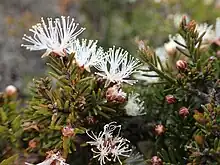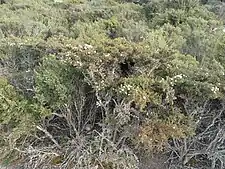| Melaleuca haplantha | |
|---|---|
 | |
| Scientific classification | |
| Kingdom: | Plantae |
| Clade: | Tracheophytes |
| Clade: | Angiosperms |
| Clade: | Eudicots |
| Clade: | Rosids |
| Order: | Myrtales |
| Family: | Myrtaceae |
| Genus: | Melaleuca |
| Species: | M. haplantha |
| Binomial name | |
| Melaleuca haplantha | |
Melaleuca haplantha is a shrub in the myrtle family, Myrtaceae and is endemic to the south-west of Western Australia. It was first described as a new species in 1988 when Bryan Barlow undertook a review of Melaleuca cuticularis and found it to include 13 separate species.

Description
Melaleuca haplantha is a spreading shrub with papery bark to about 2 m (7 ft) tall. Its leaves are arranged in alternate pairs (decussate), each leaf 3.6–10.6 mm (0.1–0.4 in) long and 0.7–2.2 mm (0.03–0.09 in) wide, linear or very narrow elliptic in shape and tapering to a point.[2]
The flowers are white to creamy-yellow, in heads at or near the ends of the branches which often continue to grow after flowering and are about 10 mm (0.4 in) in diameter. There is usually only one flower in the head but sometimes up to three flowers. The stamens are arranged in five bundles around each flower with 17 to 24 stamens per bundle. Flowering occurs during spring and is followed by fruit which are woody capsules 4–5.5 mm (0.16–0.22 in) long.[2][3][4]
Taxonomy and naming
Melaleuca haplantha was first formally described in 1988 by Bryan Barlow in Australian Systematic Botany as a new species.[5][6] The specific epithet (haplantha) is derived from Ancient Greek words meaning "single" and "flower", referring to the single-flowered inflorescence.[2]
Distribution and habitat
This melaleuca occurs between the New Norcia, Mukinbudin, Stirling Range and Hopetoun districts[2][3] in the Avon Wheatbelt, Esperance Plains and Mallee biogeographic regions.[7] It grows in clay and gravelly loam in winter-wet soil in kwongan or woodland.[4][8]
Conservation status
Melaleuca haplantha is listed as "not threatened" by the Government of Western Australia Department of Parks and Wildlife.[7]
References
- ↑ "Melaleuca haplantha". Plants of the World Online. Retrieved 30 August 2021.
- 1 2 3 4 Brophy, Joseph J.; Craven, Lyndley A.; Doran, John C. (2013). Melaleucas : their botany, essential oils and uses (PDF). Canberra: Australian Centre for International Agricultural Research. p. 191. ISBN 9781922137517. Retrieved 4 April 2015.
- 1 2 Holliday, Ivan (2004). Melaleucas : a field and garden guide (2nd ed.). Frenchs Forest, N.S.W.: Reed New Holland Publishers. p. 78. ISBN 1876334983.
- 1 2 Fuhrer, Margaret G. Corrick, Bruce A. (2009). Wildflowers of southern Western Australia (3rd ed.). Kenthurst, N.S.W.: Rosenberg Pub. p. 134. ISBN 9781877058844. Retrieved 4 April 2015.
{{cite book}}: CS1 maint: multiple names: authors list (link) - ↑ "Melaleuca haplantha". APNI. Retrieved 4 April 2015.
- ↑ Barlow, BA; Cowley, KJ (1988). "Contributions to a revision of Melaleuca (Myrtaceae): 4–6". Australian Systematic Botany. 1 (2): 105. doi:10.1071/SB9880095. Retrieved 4 April 2015.
- 1 2 "Melaleuca haplantha". FloraBase. Western Australian Government Department of Biodiversity, Conservation and Attractions.
- ↑ Paczkowska, Grazyna; Chapman, Alex R. (2000). The Western Australian flora : a descriptive catalogue. Perth: Wildflower Society of Western Australia. p. 394. ISBN 0646402439.